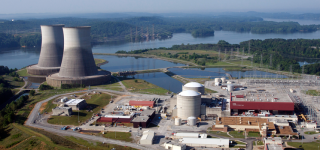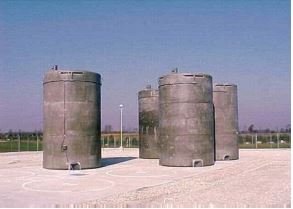Nuclear Power Plants
- Nuclear reactors create about 20% of the power in the United States.
- The United States generates more nuclear power (in gigawatt hours) than any other nation.
- Nuclear power plants must follow strict safety guidelines for the protection of workers and the surrounding public.
Nuclear power plants produce electricity from the heat created when atoms are split within a nuclear reactor. This process is called fission.
About Nuclear Power Plants
Nuclear reactors generate about 20% of all of the electricity used in the United States. Uranium is the fuel most widely used in nuclear reactors at power plants.
Nuclear energy is created when uranium atoms are split in a process called fission. Fission releases a tremendous amount of energy in the form of heat. This heat creates steam that is used to turn a steam turbine. The turbine is connected to an electric generator, which generates electricity.
Source: U.S. Department of Energy (DOE)
Radioactive materials found at nuclear power plants include enriched uranium fuel, low-level waste, and spent nuclear fuel.
- Enriched uranium is the fuel for nuclear power plants. One pellet of enriched uranium is approximately 1-inch long and can generate about the same amount of electricity as one ton of coal.
- Low-level radioactive waste includes items used at the power plant that become contaminated with radioactive material during energy production. This may include items such as shoe covers and clothing, wiping rags, mops, filters, reactor water, and tools. Low-level waste is stored at the nuclear power plant temporarily. After some time, wastes may be sent to a low-level waste disposal site. Or, when items are no longer radioactive they may be disposed of as ordinary trash.
- High-level radioactive waste includes spent (used) reactor fuel and wastes remaining after the spent fuel is reprocessed. Spent nuclear fuel is highly radioactive and stored in specially designed pools or containers. There are no high-level waste sites designed for permanent, long-term storage in the United States. High-level radioactive waste must be stored on-site at each individual nuclear power plant, currently in units called dry cask storage units.
Source: U.S. Nuclear Regulatory Commission (NRC)
Public safety is a high priority when nuclear power plants are built and operated. During normal operation, nuclear power plants release very low amounts of radioactive materials into the air. Releases from nuclear power plants must be less than federally defined limits for radioactive air emissions. These releases must be monitored by the nuclear power plant operator and reported annually to the U.S. Nuclear Regulatory Commission (NRC). These publicly available reports list the radioactive isotopes released, how much was released and any possible dose to the public.
Reactor buildings are designed to contain radiation in the case of an accident. Nuclear power plant operators are required to have plans to deal with emergencies at nuclear power plants and to practice them regularly. These emergency response plans include policies for notifying and evacuating area residents should there be an actual emergency.
What You Can Do
- Review emergency response plans. If you live within 10 miles of a nuclear power plant, learn about its emergency response plan.
- Follow emergency instructions. In the case of an accident at a nuclear power plant, listen to the radio or television for information and follow instructions from local emergency responders and government officials.


